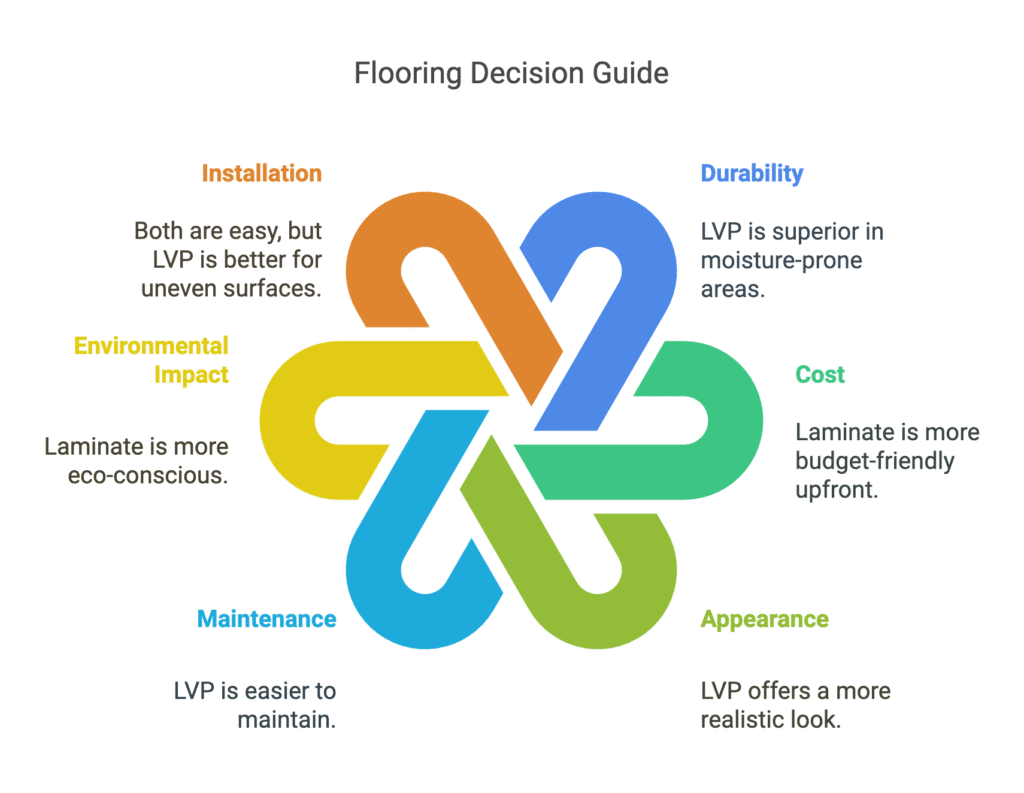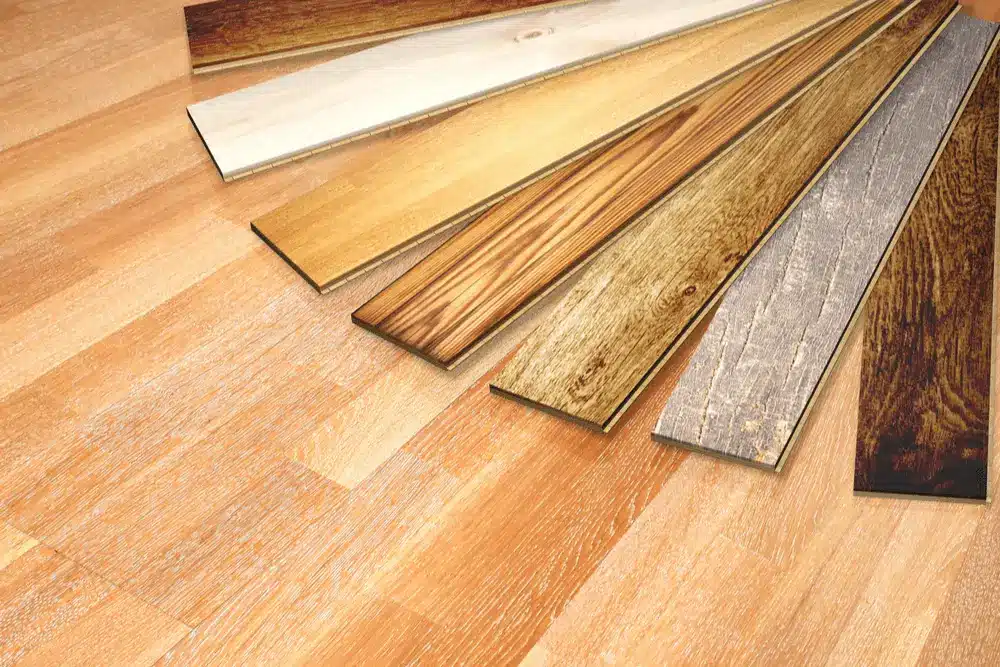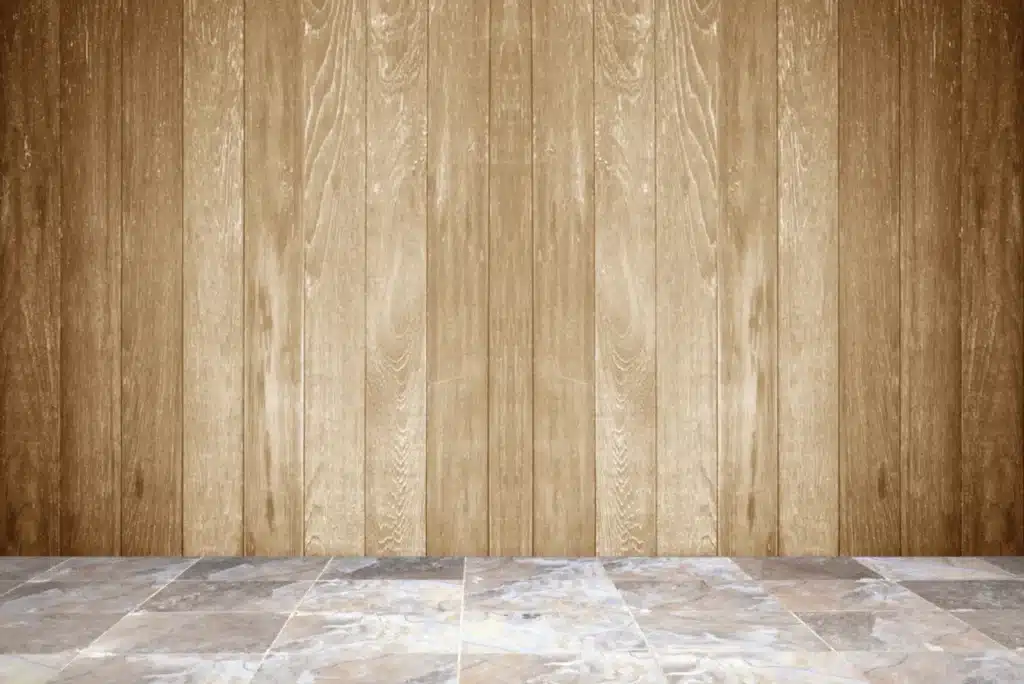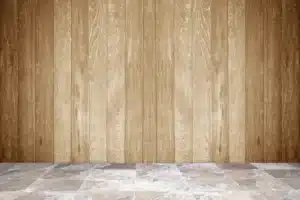When it’s time for new floors, you might find yourself deciding between laminate flooring and luxury vinyl plank (LVP). Both are popular, versatile options, but they are very different. Understanding their key differences will help you choose the flooring type that best suits your needs.
It’s time to take a deep dive into laminate flooring vs. luxury vinyl plank, covering factors like durability, cost, appearance, and maintenance. Soon you will understand which type of flooring works best for you.
Table of Contents
ToggleLaminate Flooring vs. LVP: Key Differences
Before examining specifics, here’s a quick overview of each flooring type:
Laminate flooring is constructed from compressed wood fibers with an image layer that resembles wood or stone. It’s best known for affordability and ease of installation.
Luxury vinyl plank (LVP) consists of multiple vinyl layers, offering water resistance and superior durability. LVP thrives in moisture-prone areas like kitchens and bathrooms, and its resilience also makes it an excellent choice for vinyl exercise room flooring, providing a durable, easy-to-clean surface that withstands heavy use and equipment.

Durability: Which Flooring Lasts Longer?
Laminate flooring is durable but struggles in high-moisture areas. Over time, it can develop scratches or dents, especially in high-traffic spaces. Prolonged exposure to water can cause swelling or warping, so laminate works better in bedrooms and living areas.
LVP flooring is incredibly durable and water-resistant, making it ideal for areas prone to spills or humidity, such as kitchens, bathrooms, or basements. Its resistance to scratches, dents, and fading lets it withstand various forms of wear and tear.
Verdict: For moisture-prone or high-traffic areas, LVP flooring is superior.
Cost Comparison: Which Is More Budget-Friendly?
Laminate flooring’s affordability is one of its main advantages. Prices typically range from $1–$4 per square foot, making it an ideal choice for budget-conscious home and business owners who want the look of hardwood without the hefty price tag.
LVP is on the pricier side at $2–$7 per square foot, depending on quality. While the upfront cost is higher, LVP’s durability and water resistance may save you money in repairs or replacements over time.
Verdict: Laminate flooring is more budget-friendly, but LVP flooring offers better long-term value.
Appearance: Which Flooring Looks More Realistic?
Modern laminate flooring looks similar to wood, stone, or tile, thanks to its unique image layer. However, its surface can appear less natural due to its hard, glossy finish.
LVP has a more authentic appearance, with embossed textures that mimic natural wood grain or stone patterns. It provides depth and realism, making it nearly indistinguishable from real hardwood or tile. For homeowners torn between installing LVP or restoring wood floors, LVP offers a low-maintenance alternative that captures the timeless beauty of wood without the upkeep associated with traditional hardwood.
Verdict: For a more realistic and high-end look, LVP flooring comes out on top.
Maintenance: How Easy Are They to Maintain?
Laminate flooring is low-maintenance but requires careful cleaning to avoid water damage. Regular sweeping or vacuuming removes dirt, and a damp mop can be used for light cleaning. However, excessive moisture should be avoided.
LVP flooring is easier to maintain and can handle wet cleaning methods without any issues. Its waterproof properties make it perfect for kitchens, bathrooms, and homes with kids or pets.
Verdict: LVP flooring wins in maintenance, especially in high-humidity areas.
Environmental Impact: Which Is More Sustainable?
Laminate flooring is often made from recycled wood fibers, making it an eco-friendly flooring option. However, some laminates contain adhesives or finishes that aren’t so great for the environment.
LVP flooring is made from synthetic materials, which are less sustainable. However, many brands now offer eco-friendly options that use recyclable vinyl and low-VOC emissions to minimize environmental impact.
Verdict: Laminate flooring is generally the more eco-conscious choice, but green-certified LVP options are available.
Installation: Which Is Easier to Install?
Laminate features a click-and-lock system that makes for quick installation over most subfloors. It’s a great option for homeowners who want to save on installation costs.
LVP flooring is also easy to install, using similar click-and-lock systems or peel-and-stick methods. Its flexibility makes it more forgiving on uneven surfaces, making it a better choice for older homes.
Verdict: Both flooring types are simple to install, but LVP flooring has an edge for uneven surfaces.
Best Uses for Laminate and LVP Flooring

When to Choose Laminate Flooring:
- Living rooms, dining rooms, and bedrooms
- Homes on a budget
- Spaces with minimal moisture exposure
When to Choose LVP Flooring:
- Kitchens, bathrooms, and basements
- Homes with pets or children
- High-traffic areas needing extra durability
Laminate vs. LVP: Which Flooring Is Right for Your Glendale Home?
The right flooring choice comes down to your needs, budget, and the specific conditions of your space.
- Choose Laminate Flooring: If affordability is your main concern, and you need a stylish solution for dry areas, laminate is an excellent option.
- Choose LVP Flooring: If you want superior durability, water resistance, and a realistic appearance, LVP flooring is the clear winner.
At Carpet Wagon in Glendale, CA, we specialize in helping homeowners find the perfect flooring solution. Whether you’re interested in the affordability of laminate or the resilience of LVP, our expert team is here to guide you every step of the way.Visit our Glendale showroom or schedule a consultation today to explore our wide selection of laminate flooring and LVP flooring options. Let us help you transform your home with the perfect flooring solution!



